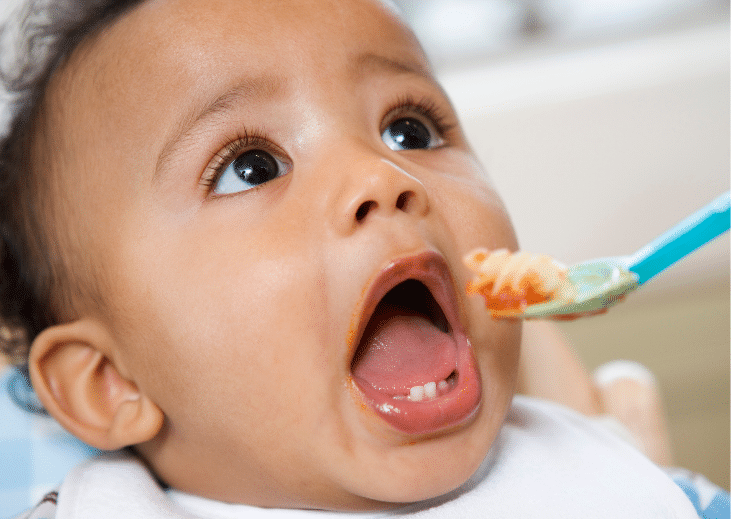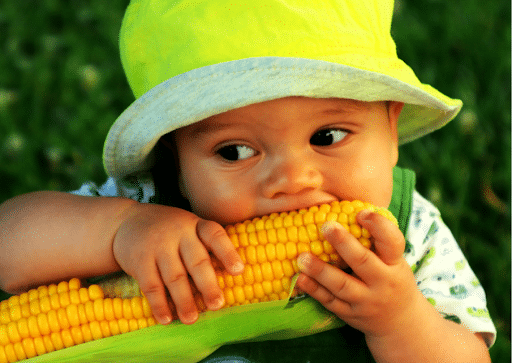By Jo Drew from Little Qwean
When the time comes to wean your baby, most parents are filled with an excited nervous energy, will my baby be a good eater? Will they choke? Will I miss the closeness of milk feeds?
Even though it is a huge milestone for your baby to go through, I always like to remind parents that humans are meant to eat food. It is a natural transition, after all, you’ve never seen an adult who only drinks milk as a result of their parents making a mistake during weaning.
Relaxing through this process is undoubtedly the most important thing to keep in mind, your baby will be excited to try food and it can be a fun experience!
The weaning process involves slowly reducing milk consumption and moving towards solid foods. This can often mean that parents get more of a break between milk feeds whether that is bottle feeding of breastfeeding. Some parents choose to continue to milk feed on demand, others decide to switch to routine feeding to ensure that their babies are hungry when they try food. Try both approaches and see what works best for you.
First things first
It is recommended that you begin weaning at 6 months of age once your baby is showing the appropriate signs that they are ready to eat, keep in mind that it is not always safe to start before these signs so consult with a pediatrician if starting before 6 months.
- Baby is able to hold their head up and sit up unassisted.
- They have lost the tongue thrust reflex; this is a reflex that helps with milk feeding but stops babies from being able to swallow solid food.
- Baby engages with the food and tries to pick it up themselves and bring it to their mouths.
Once your baby has mastered these skills then you can start the weaning journey!
There are also some forbidden foods to keep in mind when beginning weaning, they are not recommended for babies under the age of one as they can cause illness or eating problems in the future, these are:
• Salt
• Sugar
• Drinks other than breastmilk or formula (you can offer small amounts of water but speak to your pediatrician first)
• Mould-ripened cheese such as Brie
• Unsaturated dairy products
• Rare meats, fish or eggs
• Honey

There are 3 types of weaning, Spoon-feeding, Baby Led Weaning and Combination feeding. Whichever you choose I would recommend that you do a short baby first aid course to prepare you for what you need to do in case of choking or allergic reactions, this sounds scary and hopefully you never have to go through this but its always better to be prepared.
So now you are ready to begin and have chosen a form of weaning (if not we will have more information on types of weaning shortly), I want to explain a little of the psychology behind weaning.
There are 3 stages to weaning when it comes to development.
The first stage of weaning
This is where your baby is ready to transition to solid foods and has lost their tongue thrust reflex allowing them to swallow solid food. This stage is usually from the ages of 6-9 months. It is important to note that swallowing is a reflex but chewing is not! It is something that we have to teach our babies to do, that is why many new parents are deciding to go with the Baby Led Weaning approach as it is better at teaching babies how to chew. If you only feel comfortable starting with purees that is also absolutely fine, but I would recommend letting the baby use the spoon themselves so that they are still learning to move something around their mouths, this is called mapping, it means that the baby learns the sensations all around their mouths and it makes eating much safer. For example, if I put food here it makes me gag, if I put food here it helps me chew, etc.
During this stage of weaning, you want to offer your baby their milk first, about an hour before the solid food, breastmilk or formula is still their primary source of nutrition. You also want to offer a large variety of different tastes. Do not be put off by funny facial expressions, it can take babies up to 8 tries of one food to decide if they like it or not so just keep offering them a variety of healthy options. Right now, they are just practising, getting their hand-eye-coordination right and mapping their mouths. It is a new set of skills; they won’t be good at it for a while and some days they will outright refuse but just be consistent and patient.
The second stage of weaning
The second stage of weaning happens at around 9 months to 1 year, this is when your baby develops the pincer grasp, meaning they can pick up small items with their thumb and index finger. This also means that they will start to shove much more food into their mouths faster than they can chew so teaching your baby how to spit food out is a good idea for this stage. You can do this by getting lower than the baby, perhaps kneeling down below the baby chair and roleplaying spitting something out of your mouth into your hand. This encourages them to look down which helps them to spit out and they will likely try to copy your behaviour. When you are preparing food for your baby at this age you should try to chop food into odd shaped bitesize pieces to allow them to eat safely. Adapt hard, slippery, or round shaped foods to prevent them from being a choking hazard by cutting them up, mashing them or cooking them till they are soft. You can now start to offer solid foods first and then their milk about an hour after they have eaten as you move towards food being the primary source of nutrition after one year.
The third stage of weaning
The last stage of weaning is after one year, this is when your baby can eat everything that you eat (with no added salt). Parents who have done Baby Led Weaning throughout will have already been doing this since the start of weaning, but I am referring more to 1 year being the age where babies can safely eat most foods with salt as an exception. Now that your baby is eating family meals this is where most of their nutrition comes from, though it is widely recommended that babies are breastfed up until the age of two, this isn’t always a possibility to most mothers, and some choose to stop breastfeeding at this age. You can now offer other forms of milk to your baby, the most popular choice of milk would be full fat pasteurised cows’ milk, but other milks can also works, just try to stay away from oat milk or rice milk as they do not offer enough fat or protein. Try to only offer around 350ml of milk per day as too much milk at this stage can inhibit iron absorption which is crucial to your baby’s healthy growth.

To sum up:
- The first stage of weaning- around 6 months where baby learns to chew and swallow. Milk feeds before food.
- The second stage of weaning- around 9 months where baby learns to pick up food themselves. Food before milk feeds.
- The third stage of weaning- around 1 year where baby is ready for family meals and may transition to milks other than breastmilk or formula.
Weaning can be a really great time for you and your baby, you can spend time together at the table, provide healthy nutritious meals, watch your baby try new things and learn new skills.
If you find it overwhelming, don’t be afraid to reach out to us for tips, meals, recipes, or advice!


